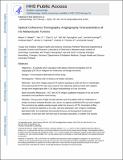Optical Coherence Tomography Angiography Characteristics of Iris Melanocytic Tumors
Author(s)
Lu, Chen David; Lee, ByungKun; Husvogt, Lennart; Fujimoto, James G
DownloadAccepted version (1.369Mb)
Publisher with Creative Commons License
Publisher with Creative Commons License
Creative Commons Attribution
Terms of use
Metadata
Show full item recordAbstract
Purpose To evaluate tumor vasculature with optical coherence tomography angiography (OCTA) in malignant iris melanomas and benign iris lesions. Design Cross-sectional observational clinical study. Participants Patients with iris lesions and healthy volunteers. Methods Eyes were imaged using OCTA systems operating at 1050- and 840-nm wavelengths. Three-dimensional OCTA scans were acquired. Iris melanoma patients treated with radiation therapy were imaged again after I-125 plaque brachytherapy at 6 and 18 months. Main Outcome Measures OCT and OCTA images, qualitative evaluation of iris and tumor vasculature, and quantitative vessel density. Results One eye each of 8 normal volunteers and 9 patients with iris melanomas or benign iris lesions, including freckles, nevi, and an iris pigment epithelial (IPE) cyst, were imaged. The normal iris has radially oriented vessels within the stroma on OCTA. Penetration of flow signal in normal iris depended on iris color, with best penetration seen in light to moderately pigmented irides. Iris melanomas demonstrated tortuous and disorganized intratumoral vasculature. In 2 eyes with nevi there was no increased vascularity; in another, fine vascular loops were noted near an area of ectropion uveae. Iris freckles and the IPE cyst did not have intrinsic vascularity. The vessel density was significantly higher within iris melanomas (34.5%±9.8%, P < 0.05) than in benign iris nevi (8.0%±1.4%) or normal irides (8.0%±1.2%). Tumor regression after radiation therapy for melanomas was associated with decreased vessel density. OCTA at 1050 nm provided better visualization of tumor vasculature and penetration through thicker tumors than at 840 nm. But in very thick tumors and highly pigmented lesions even 1050-nm OCTA could not visualize their full thickness. Interpretable OCTA images were obtained in 82% of participants in whom imaging was attempted. Conclusions This is the first demonstration of OCTA in iris tumors. OCTA may provide a dye-free, no-injection, cost-effective method for monitoring a variety of tumors, including iris melanocytic lesions, for growth and vascularity. This could be helpful in evaluating tumors for malignant transformation and response to treatment. Penetration of the OCT beam remains a limitation for highly pigmented tumors, as does the inability to image the entire iris in a single field.
Date issued
2017-02Department
Massachusetts Institute of Technology. Computer Science and Artificial Intelligence Laboratory; Massachusetts Institute of Technology. Department of Electrical Engineering and Computer Science; Massachusetts Institute of Technology. Research Laboratory of ElectronicsJournal
Ophthalmology
Publisher
Elsevier BV
Citation
Skalet, Alison H. et al. “Optical Coherence Tomography Angiography Characteristics of Iris Melanocytic Tumors.” Ophthalmology, 124, 2 (February 2017): 197–204 © 2017 The Author(s)
Version: Author's final manuscript
ISSN
0161-6420